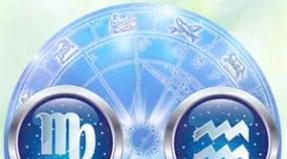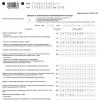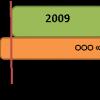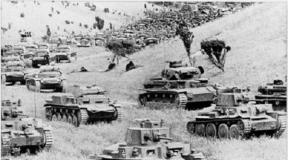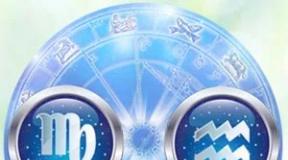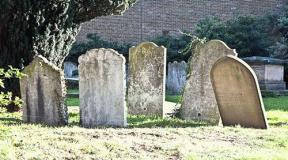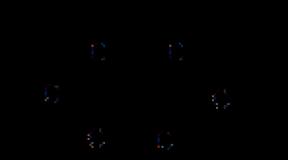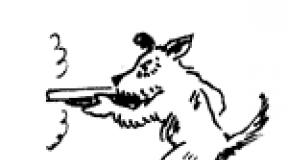Thomas Hunt Morgan: biography, contributions to biology. Biography of Thomas Morgan achievements in biology and genetics
In 1890 he received a doctorate from Johns Hopkins University and in the same year received an Adam Bruce Fellowship, which allowed him to travel to Europe, to the Marine Zoological Laboratory. There he met Hans Drich and Kurt Herbst. It was under Driech's influence that Morgan began to become interested in experimental embryology.
From 1904 to 1928 he held the position of professor of experimental zoology at Columbia University (New York), and from 1928 to 1945 - professor of biology and laboratory director at the California Institute of Technology (Pasadena). In the last years of his life, he acquired a small laboratory in Corona del Mar (California).
In one of his early works, Morgan criticizes the Mendelian theory of heredity. He believed that chromosomes are not carriers of heredity, but are products of early stages of development. He also did not support Darwin’s idea of “gradual change,” preferring the version of the Dutch botanist Hugo de Vries that the emergence of a new species is the result of mutations.
At that time, almost nothing was known about the mechanism of inheritance, and the method of studying the process of evolution and heredity was to compare the morphology and physiology of representatives of different species. Based on the data obtained, scientists tried to draw conclusions about the reasons for the similarities or differences between existing species. Morgan was no exception; his first works on the study of heredity were carried out in accordance with generally accepted methods. By 1891, he had completely mastered comparative and descriptive research methods, but they did not provide answers to the questions that interested him, and he turned to experiments, hoping to obtain a specific result. In 1897, while studying the ability of some organisms to regenerate lost body parts, he published the first article on the phenomenon of regeneration, which contributes to the successful survival of the species.
In 1900, the focus of attention of geneticists around the world was Mendel's work on the inheritance of traits in peas. In these works, Mendel argued that traits are inherited according to strict mathematical laws.
In 1902, biologist W. Sutton proposed that units of heredity (genes) are located inside or on the surface of structures in the cell nucleus called chromosomes.
Morgan did not agree with this, believing that chromosomes are products of an early stage of organism development.
In 1909 Morgan began working with the fruit fly Drosophila.
Best of the day
Back in 1900–1901, C.W. Woodworth studied Drosophila as experimental material and was the first to suggest that Drosophila could be used in genetic research, in particular, to study inbreeding. Drosophila has only 4 pairs of chromosomes, it begins to reproduce two weeks after its birth and after 12 days brings offspring of 1000 individuals. V.E. Castle and F.E. Lutz also worked with Drosophila, who introduced the results of their work to Morgan, who was looking for cheaper experimental material for his scientific research.
Very soon (in 1909) the first mutations appeared. Subsequent study of this phenomenon ultimately allowed the scientist to establish the exact location of the genes and the principle of their operation. One of the most important discoveries can be considered the “dependence” of certain mutations on gender (Morgan called this phenomenon “linkage” of genes): white eyes in fruit flies were transmitted only to males. After processing a large amount of information, Morgan came to interesting conclusions: genes located on the same chromosome were inherited together much less often than might be expected. Consequently, it is possible for chromosomes to split and exchange genetic material between chromosomes and genes. The farther apart genes are located on a chromosome, the higher the likelihood of them being broken. Based on this, Morgan and his colleagues compiled “maps” of Drosophila chromosomes. His guess about the “linear” arrangement of genes on a chromosome, and that the “linkage” of genes depends on the distance of one gene from another, is one of the revolutionary discoveries in genetics.
In 1919 he was elected a Foreign Member of the Royal Society of London, in 1924 he was awarded the Darwin Medal; in 1933 he received the Nobel Prize for discoveries related to the functions of chromosomes in the transmission of heredity.
Major works: Regeneration. N-Y: Macmillan, 1901; Heredity and Sex. N-Y: Columbia Univ. Press, 1913; The Theory of the Gene. New Haven, CT: Yale Univ. Press, 1932; The Scientific Basis of Evolution. London: Faber and Faber, 1932.
The greatest insights in biology of the 19th and 20th centuries are rightfully considered to be the works of Charles Darwin on evolution, Gregor Mendel on heredity and variability, and Thomas Hunt Morgan on genes and chromosomes. It was Morgan's work that opened up the experimental path of development for genetics. Gregor Mendel and Thomas Hunt Morgan are biologists who became luminaries and it is to them that all modern molecular biologists should be grateful. Their intuitively chosen research subjects opened the door to the world of genome sequencing, genetic engineering and transgenic breeding.
At the right time and in the right place
The biography of Thomas Hunt Morgan does not contain tragic rejection by colleagues, persecution for his ideas, loneliness, undeserved oblivion and unappreciation during his lifetime. He lived for a long time surrounded by close people, built a successful career as a researcher and teacher, and became one of the luminaries and icons of fundamental genetics - a science whose representatives today receive more Nobel Prizes than scientists in any other field.
The work of Thomas Hunt Morgan and his students and co-authors at the beginning of the 20th century absorbed all the accumulated genetic data, the results of research into cell division (mitosis and meiosis), and conclusions about the role of the cell nucleus and chromosomes in the inheritance of traits. His chromosome theory explained the nature of human hereditary pathologies, made it possible to experimentally change hereditary information and became the beginning of modern methods of genetic research. Although not a pioneer, Thomas Hunt Morgan formulated the postulates of a theory that changed the world. After his works, writers’ fantasies about life extension, human transformations and the creation of new organs became just a matter of time.
Aristocratic origin
On an autumn day in 1866, in the city of Lexington in the American state of Kentucky, the nephew of the legendary General of the Confederate Army Francis Ghent Morgan and the great-grandson of the first millionaire in the southwestern part of the United States was born. His father, Charleston Hunt Morgan, is a successful diplomat and American consul in Sicily. Mother - Ellen - granddaughter of the author of the American national anthem, Francis Scott Key. Thomas was interested in biology and geology from childhood. From the age of ten, he spent his free time collecting stones, feathers and bird eggs in the Kentucky mountains. As he grew older, he spent his summers helping USGS research teams in the same mountains that were already home to him. After graduating from school, the boy entered Kentucky College and received a bachelor's degree in 1886.
Student years
After graduating from school, Thomas Morgan entered the only university at that time - named in Baltimore (Maryland). There he became interested in the morphology and physiology of animals. His first scientific work was on structure and physiology. He then took up embryology at Woods Hall Laboratory, visiting Jamaica and the Bahamas. He received his master's degree, defended his dissertation, and in 1891 headed the biology department at Bryn Myre College. Since 1894, Thomas Hunt Morgan has been interning at the Zoological Laboratory of Naples. From the study of embryology, the scientist moves on to the study of the inheritance of characteristics. At that time, there was a debate in scientific circles between preformationists (supporters of the presence in gametes of structures that predetermine the formation of the organism) and epigenists (supporters of development under the influence of external factors). Atheist Thomas Hunt Morgan takes a middle position on this issue. Returning from Naples in 1895, he received the title of professor. Studying the abilities of regeneration, he wrote two books - The Development of the Frog's Egg (1897) and Regeneration (1900), but continued to study heredity and evolution. In 1904, Thomas married his student Lillian Vaughan Sampson. She not only bore him a son and three daughters, but also became his colleague and assistant in his work.

Columbia University
Since 1903, Morgan has held the post of professor in the department of experimental zoology at the mentioned university. It was here that he would work for 24 years and make his famous discoveries. Evolution and inheritance are the main topics of the scientific community of the time. Scientists are looking for confirmation of the theory of natural selection and Mendel’s laws of inheritance “rediscovered” by Hugo de Vries. Forty-four-year-old Thomas Hunt Morgan decides to experimentally test the correctness of Georg Mendel and for many years becomes the “lord of the flies” - fruit flies. The successful choice of an object for experiments made these insects the “sacred cow” of all geneticists for many centuries.
A successful object and associates are the key to success
Drosophila melanogaster - a small red-eyed fruit fly - turned out to be an ideal experimental subject. It is easy to keep - up to a thousand individuals can easily live in a one and a half liter milk bottle. She reproduces already in the second week of life, she has well-defined sexual dimorphism (external differences between males and females). Best of all, these flies have only four chromosomes and can be studied throughout their three-month lifespan. Over the course of a year, an observer can track changes and inheritance of traits in more than thirty generations. Morgan's experiments were helped by his most talented students, who became colleagues and co-authors - Calvin Bridgers, Alfred Sturtevant, Herman Joseph Meller. This is exactly how the legendary “fly room” - laboratory No. 613 in the Shemeron building of Columbia University - was equipped from milk bottles stolen from Manhattan residents.

Innovative teacher
Morgan’s “fly room” not only became famous throughout the world and became a place of pilgrimage for scientists. This room with an area of 24 m2 changed the very organization of the educational process. The scientist built his work on the principles of democracy, free exchange of opinions, lack of subordination, complete transparency for all participants and collective brainstorming when discussing results and planning experiments. It was this teaching method that became prevalent in all universities in America, and later spread to Europe.
Drosophila with pink eyes
Morgan and his students began experiments, setting themselves the task of elucidating the principles of inheritance of mutations. Two long years of breeding flies did not produce any visible progress. But a miracle happened - individuals with pink eyes, rudiments of wings, and a yellow body appeared, and it was they who provided the material for the emergence of the theory of inheritance. Numerous crossings and counting of thousands of descendants, shelves with thousands of bottles and millions of fruit flies - this is the price of success. Convincing evidence of sex-linked inheritance and storage of information about a trait in a specific region (locus) of chromosomes appeared in the scientist’s article “Sex-Linked Inheritance” (“Sex Limited Inheritance in Drosophila”, 1910).

Chromosome theory
The result of all the experiments, Thomas Hunt Morgan's contribution to biology was his theory of inheritance. Its main postulate is that the material basis of heredity is chromosomes, in which genes are arranged in a linear order. Thomas Hunt Morgan's discoveries of linked genes that are inherited together and traits that are inherited with sex stunned the world (“Mechanisms of Mendelean Inheritance,” 1915). And this happened just a few years after the introduction of the very concept of “gene” into biology as a structural unit of heredity (V. Johannsen, 1909).

Professional recognition
Although the train of universal fame did not follow the scientist, one academy after another made him a member. In 1923, he became a member of the USSR Academy of Sciences. Member of the Royal Society of London, the American Philosophical Society and many other internationally recognized organizations. In 1933, for his discoveries related to the role of chromosomes in heredity, the biologist was awarded the Nobel Prize, which he himself shared with Bridges and Startevant. His arsenal includes the Darwin Medal (1924) and the Copley Medal (1939). The Kentucky Department of Biology and the Genetic Society of America's annual award are named after him. A unit of gene linkage is called a morganid.

After fame
From 1928 until his death, Professor Thomas Morgan headed the Kirchhoff Laboratories at the California Institute of Technology (Pasadena, USA). Here he became the organizer of the Department of Biology, which raised seven Nobel Prize winners in genetics and evolution. He continued to study the laws of inheritance in pigeons and rare mice, regeneration and the development of secondary sexual characteristics in salamanders. He even bought and equipped a laboratory in the Californian town of Corona del Mar. He died suddenly in Pasadena on December 4, 1945 from a gastric hemorrhage.

Summarizing
In short, Thomas Hunt Morgan's contribution to biology is comparable to such breakthroughs in human thought as the discovery of the nuclear nucleus in physics, human exploration of outer space, and the development of cybernetics and computer technology. A friendly person with a subtle sense of humor, self-confident, but simple and unpretentious in everyday life - this is how his family and associates remembered him. A pioneer who did not strive to become a hero of myths, but, on the contrary, wanted to rid the world of myths and prejudices. Which promised not sensations, but a scientific understanding of the subject. In a time when poets were more than poets, and great scientists were more than great scientists, Thomas Hunt Morgan managed to remain just a biologist.
Thomas Hunt Morgan
Thomas Hunt Morgan is a famous biologist and geneticist, winner of the Nobel Prize in Physiology or Medicine in 1933.
Thomas Hunt Morgan was born in Kentucky on September 25, 1866, into a very distinguished, by American standards, family of a diplomat. Morgan was the great-grandson of composer Francis Scott
Key, author of the US anthem.
In 1886, Thomas Morgan graduated from Kentucky State College and received a bachelor's degree.
In 1887, Morgan entered Johns Hopkins University, and in 1890 he received a doctorate for studying the embryos of sea spiders and in the same year he received an Adam Bruce Fellowship, which allowed him to travel to Europe to the Marine Zoological Laboratory. There he met Hans Drich and Kurt Herbst. It was under Driech's influence that Morgan began to become interested in experimental embryology.
In 1888–1889 he was engaged in scientific research at the American Fisheries Committee.
In 1891, Thomas Morgan began work as an associate professor of biology at Bryn Myhra Women's College.
In 1901, Morgan's first fundamental work, Regeneration, was published, devoted to the ability of some species to restore lost body parts.
From 1904 to 1928 he served as professor of experimental zoology at Columbia University (New York), and from 1928 to 1945 - professor of biology and laboratory director at the California Institute of Technology (Pasadena). In the last years of his life, he acquired a small laboratory in Corona del Mar (California).
In 1904 Morgan married Lillian Vaughan Sampson, a student of his from Bryn Mawr.
When the results of August Weismann became known, who found out that hereditary qualities are transmitted using chromosomes, scientists remembered another scientist - Mendel, who had earlier shown that heredity is transmitted by genes.
At first, Thomas Morgan was skeptical of theories that claimed that chromosomes were carriers of heredity. Likewise, Morgan did not accept Darwin's hypothesis of the accumulation of gradual changes.
In 1902, biologist W. Sutton proposed that units of heredity (genes) are located inside or on the surface of structures in the cell nucleus called chromosomes. Morgan did not agree with this, believing that chromosomes are products of an early stage of organism development. He liked more the idea expressed by the Dutchman Hugo de Vries, that a new species is formed as a result of mutations. In order to confirm this hypothesis, Thomas Morgan began to look for a convenient object for research. He needed an unpretentious animal with a fast life cycle.
Back in 1900–1901, C.W. Woodworth studied Drosophila as experimental material and was the first to suggest that Drosophila could be used in genetic research, in particular, to study inbreeding. Drosophila has only 4 pairs of chromosomes, it begins to reproduce two weeks after its birth and after 12 days brings offspring of 1000 individuals. It is easy to study during a life span of only 3 months. Plus it costs almost nothing. V.E. Castle and F.E. Lutz also worked with Drosophila, who suggested that Morgan work with the fruit fly.
Since 1908, Morgan began observing Drosophila, which was ideal for studying heredity.
Morgan's fly-room at Columbia University has become legendary. In many jars and bottles, myriads of flies were hatched from larvae and devoted themselves to science. There were always not enough bottles, and, according to the legend, in the early morning on the way to the laboratory, Morgan and his students stole milk bottles, which Manhattan residents put outside their doors in the evening.
By raising flies in glass jars and observing them under a microscope, Morgan discovered the appearance of white-eyed flies, yellow-eyed flies and even pink-eyed flies in addition to the usual red-eyed flies. Over the course of ten years, many different mutants have been discovered in Drosophila.
Morgan crossed flies, observing a huge number of characteristics: eye color, body color, unequal number of bristles, varied shape and size of wings.
Analyzing the results of observations, Thomas Morgan came to the conclusion that a number of qualities are transmitted to descendants in the aggregate. This made it possible to hypothesize that genes are not scattered throughout the cell, but are linked into certain islands.
The fruit fly has only four pairs of chromosomes. Accordingly, Morgan divided the hereditary characteristics of Drosophila into four groups. He came to the conclusion that genes are localized on chromosomes. Each chromosome contains hundreds of genes organized in chains.
Thomas Morgan showed that the greater the distance between two genes, the greater the likelihood of a chain break. This meant that distantly located genes could not be inherited together. Conversely, closely located genes are less likely to be separated. Professor Thomas Morgan and his colleagues found that the magnitude of the linear distance between genes can characterize the degree of linkage of genes. Morgan's discoveries made it possible to claim that heredity could be described by precise quantitative methods. Based on his theory, Thomas Morgan compiled a map of the location of genes in Drosophila chromosomes.
One of the important discoveries is the “dependence” of certain mutations on sex (Morgan called this phenomenon “linkage” of genes): white eyes in fruit flies were transmitted only to males. This is how sex chromosomes were discovered.
After processing a large amount of information, Morgan came to interesting conclusions: genes located on the same chromosome were inherited together much less often than might be expected.
Morgan published his first article about Drosophila in 1910, but his arguments were presented in full force in 1915, when his students - Sturtevant, Bridges and Meller, published the book Mechanisms of Mendelian Inheritance, in which they declared that heredity obeys very specific laws, and it can be described by precise quantitative methods. This opened the way to the targeted design of new varieties of plants and animal breeds, to a revolution in medicine and agriculture.
Morgan was already approaching fifty and professional recognition was not long in coming. In 1919 he was elected a Foreign Member of the Royal Society of London, and in 1924 he was awarded the Darwin Medal. Morgan became a member of the academies of sciences of different countries (and also, in December 1923, a member of the Academy of Sciences of the USSR). In the late 20s, he headed the US National Academy of Sciences. In 1933, Thomas Morgan was awarded the Nobel Prize in Physiology or Medicine for his discoveries related to the role of chromosomes in heredity.
Morgan died in 1945 in Pasadena.
1. The founder of the chromosome theory, Thomas Gent Morgan, American geneticist, Nobel laureate. Morgan and his students found that:
– each gene has a specific locus(place);
– genes on a chromosome are located in a certain sequence;
– the most closely located genes on one chromosome are linked, therefore they are inherited predominantly together;
– groups of genes located on the same chromosome form linkage groups;
– the number of clutch groups is equal haploid set of chromosomes homogametic individuals and n+1 heterogametic individuals;
– between homologous chromosomes there can be an exchange of sections ( crossing over); as a result of crossing over, gametes arise whose chromosomes contain new combinations of genes;
– the frequency (in%) of crossing over between non-allelic genes is proportional to the distance between them;
– set of chromosomes in cells of a given type ( karyotype) is a characteristic feature of the species;
– the frequency of crossing over between homologous chromosomes depends on the distance between genes localized on the same chromosome. The greater this distance, the higher the crossing over frequency. The unit of distance between genes is taken to be 1 morganid (1% crossing over) or the percentage of occurrence of crossing over individuals. If this value is 10 morganids, it can be stated that the frequency of chromosome crossings at the locations of these genes is 10% and that new genetic combinations will be identified in 10% of the offspring. To clarify the nature of the location of genes on chromosomes and determine the frequency of crossing over between them, genetic maps are constructed. The map reflects the order of genes on a chromosome and the distance between genes on the same chromosome. These conclusions of Morgan and his colleagues were called the chromosomal theory of heredity. The most important consequences of this theory are modern ideas about the gene as a functional unit of heredity, its divisibility and ability to interact with other genes.
2. Chromosome sets of different sexes differ in the structure of sex chromosomes. The male Y chromosome does not contain many of the alleles found on the X chromosome. Traits determined by the genes of the sex chromosomes are called sex-linked. The pattern of inheritance depends on the distribution of chromosomes in meiosis. In heterogametic sexes, traits that are linked to the X chromosome and do not have an allele on the Y chromosome appear even when the gene that determines the development of these traits is recessive. In humans, the Y chromosome is passed from father to sons, and the X chromosome to daughters. Children receive the second chromosome from their mother. It is always the X chromosome. If the mother carries a pathological recessive gene on one of the X chromosomes (for example, the gene for color blindness or hemophilia), but is not sick herself, then she is a carrier. If this gene is passed on to sons, they may end up with this disease, because the Y chromosome does not have an allele that suppresses the pathological gene. The sex of an organism is determined at the moment of fertilization and depends on the chromosome complement of the resulting zygote. In birds, females are heterogametic, and homogametic– males.
3. An example of sex-linked inheritance. It is known that in humans there are several traits linked to the X chromosome. One such sign is the absence of sweat glands. This is a recessive trait; if the X chromosome carrying the gene that determines it gets to a boy, then this trait will certainly manifest itself in him. If you read Patrick Suskind's famous novel "Perfume", then you remember that it was about a baby who had no smell. Consider an example of sex-linked inheritance. The mother has sweat glands, but she is a carrier of a recessive trait - Chr X, the father is healthy - XY. Mother's gametes - Xp, X. Father's gametes - X, U.
From this marriage, children with the following genotypes and phenotypes can be born:
Nonallelic genes can also interact with each other. An example of such interaction could be the appearance of new growths when crossing two outwardly identical forms. For example, the inheritance of comb shape in chickens is determined by two genes - R and P: R - rose-shaped comb, P - pisiform comb.
F1 RrPp – appearance of a nut-shaped ridge in the presence of two dominant genes; with the GGRR genotype, a leaf-shaped ridge appears.
Questions for self-control on the topic:
1. How many pairs of chromosomes are responsible for the inheritance of sex in dogs if their diploid set is 78?
1) one 2) two 3) thirty-six 4) eighteen
2. Patterns of linked inheritance apply to genes located in:
1) different non-homologous chromosomes 2) homologous chromosomes
3) on one chromosome 4) non-homologous chromosomes
3. A colorblind man married a woman with normal vision, a carrier of the colorblind gene. What genotype cannot they have a child with?
1) ХdХ 2) XX 3) ХdХd 4) ХУ
4. What is the number of gene linkage groups if it is known that the diploid set of chromosomes of an organism is 36?
1) 72 2) 36 3) 18 4) 9
5. The frequency of crossing over between genes K and C is 12%, between genes B and C – 18%, between genes K and B – 24%. What is the probable order of genes on a chromosome if they are known to be linked.
1) K-S-V 2) K-V-S 3) S-V-K 4) V-K-S
6. What will be the phenotypic cleavage in the offspring obtained from crossing black (A) shaggy (B) guinea pigs heterozygous for two traits linked on one chromosome?
1) 1: 1 2) 2: 1 3) 3: 1 4) 9: 3: 3: 1
7. From crossing two gray rats heterozygous for two color traits, 16 individuals were obtained. What will the ratio of offspring be if it is known that gene C is the main color gene and in its presence gray, white and black individuals appear, and the second gene A affects the distribution of pigment. Gray individuals appear in his presence.
1) 9 grey, 4 black, 3 white 2) 7 black, 7 black, 2 white
3) 3 black, 8 white, 5 gray 4) 9 gray, 3 black, 4 white
8. A married couple had a hemophiliac son. He grew up and decided to marry a healthy woman who does not carry the hemophilia gene. What are the possible phenotypes of the future children of this couple if the gene is linked to the X chromosome?
1) all girls are healthy and not carriers, and boys are hemophiliacs 2) all boys are healthy, and girls are hemophiliacs 3) half of the girls are sick, boys are healthy
4) all girls are carriers, boys are healthy
9. Make a forecast for the appearance of a colorblind grandson for a colorblind man and a healthy woman who does not carry the colorblind gene, provided that all his sons marry healthy women who do not carry the colorblind gene, and his daughters marry healthy men. Support your answer by recording the crossing pattern.
On physiology and medicine, 1933.
Born on September 25, 1866 in Lexington, (Kentucky, USA) in the family of a diplomat. He graduated from the University of Kentucky and received a bachelor's degree in 1886. After graduation, he worked at Johns Hopkins University.
In 1888–1889 he was engaged in scientific research at the American Fisheries Committee.
In 1890 he received a doctorate from Johns Hopkins University and in the same year received an Adam Bruce Fellowship, which allowed him to travel to Europe, to the Marine Zoological Laboratory. There he met Hans Drich and Kurt Herbst. It was under Driech's influence that Morgan began to become interested in experimental embryology.
From 1904 to 1928 he held the position of professor of experimental zoology at Columbia University (New York), and from 1928 to 1945 - professor of biology and laboratory director at the California Institute of Technology (Pasadena). In the last years of his life, he acquired a small laboratory in Corona del Mar (California).
In one of his early works, Morgan criticizes the Mendelian theory of heredity. He believed that chromosomes are not carriers of heredity, but are products of early stages of development ( cm. MENDEL, GREGOR JOHANN). He also did not support Darwin’s idea of “gradual change,” preferring the version of the Dutch botanist Hugo de Vries that the emergence of a new species is the result of mutations ( cm. POPULATION GENETICS).
At that time, almost nothing was known about the mechanism of inheritance, and the method of studying the process of evolution and heredity was to compare the morphology and physiology of representatives of different species. Based on the data obtained, scientists tried to draw conclusions about the reasons for the similarities or differences between existing species. Morgan was no exception; his first works on the study of heredity were carried out in accordance with generally accepted methods. By 1891, he had completely mastered comparative and descriptive research methods, but they did not provide answers to the questions that interested him, and he turned to experiments, hoping to obtain a specific result. In 1897, while studying the ability of some organisms to regenerate lost body parts, he published the first article on the phenomenon of regeneration, which contributes to the successful survival of the species.
In 1900, the focus of attention of geneticists around the world was Mendel's work on the inheritance of traits in peas. In these works, Mendel argued that traits are inherited according to strict mathematical laws.
In 1902, biologist W. Sutton proposed that units of heredity (genes) are located inside or on the surface of structures in the cell nucleus called chromosomes.
Morgan did not agree with this, believing that chromosomes are products of an early stage of organism development.
In 1909 Morgan began working with the fruit fly Drosophila.
Back in 1900–1901, C.W. Woodworth studied Drosophila as experimental material and was the first to suggest that Drosophila could be used in genetic research, in particular, to study inbreeding. Drosophila has only 4 pairs of chromosomes, it begins to reproduce two weeks after its birth and after 12 days brings offspring of 1000 individuals. V.E. Castle and F.E. Lutz also worked with Drosophila, who introduced the results of their work to Morgan, who was looking for cheaper experimental material for his scientific research.
Very soon (in 1909) the first mutations appeared. Subsequent study of this phenomenon ultimately allowed the scientist to establish the exact location of the genes and the principle of their operation. One of the most important discoveries can be considered the “dependence” of certain mutations on gender (Morgan called this phenomenon “linkage” of genes): white eyes in fruit flies were transmitted only to males. After processing a large amount of information, Morgan came to interesting conclusions: genes located on the same chromosome were inherited together much less often than might be expected. Consequently, it is possible for chromosomes to split and exchange genetic material between chromosomes and genes. The farther apart genes are located on a chromosome, the higher the likelihood of them being broken. Based on this, Morgan and his colleagues compiled “maps” of Drosophila chromosomes. His guess about the “linear” arrangement of genes on a chromosome, and that the “linkage” of genes depends on the distance of one gene from another, is one of the revolutionary discoveries in genetics.
In 1919 he was elected a Foreign Member of the Royal Society of London, in 1924 he was awarded the Darwin Medal; in 1933 he received the Nobel Prize for discoveries related to the functions of chromosomes in the transmission of heredity.
Morgan died in 1945 in Pasadena.
Main works: Regeneration. N-Y: Macmillan, 1901; Heredity and Sex. N-Y: Columbia Univ. Press, 1913; The Theory of the Gene. New Haven, CT: Yale Univ. Press, 1932; The Scientific Basis of Evolution. London: Faber and Faber, 1932.
Irina Shanina

